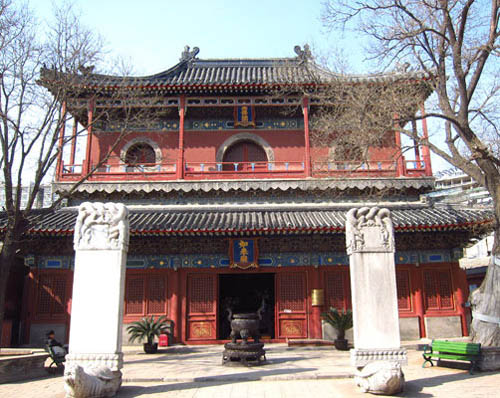Hu Qingxue, 40, a farm lad from Gu’an County in Hebei Province began in his teens to learn traditional musical notation. At 17 he enrolled in the classes of Zhang Benxing, a master of Jing Music at Beijing’s Zhihua Temple, which dates back to the early Ming Dynasty (1368-1644). Hu is now a government-recognized successor to this national intangible cultural heritage.
 |
|
Zhihua Temple's Hall of Tathagata, home to over ten thousand Buddhas. Photo taken by William Wang for CRI, March 2012.
|
Lumicang (Rice Granary) Alley, to the west of the East 2nd Ring Road in central Beijing, is a hideaway, a refuge from the hustle and bustle of the commercial district around it. Mottled brick walls, low-lying courtyard homes and quiet lanes strewn with fallen leaves, all form a serene backdrop to this 500-year-old Zhihua Temple from the Ming Dynasty.
Royal patronage a thing of the distant past, the temple still retains a national reverence for its legacy of Jing Music, a blend of court, Buddhist and folk music, lauded as a “living fossil” of ancient Chinese music. It has been handed down orally through 27 generations. Hu Qingxue is the latest in that long line.
Waning Refrains
In the 1950s, a monk at Zhihua Temple discovered an ancient music book at the bottom of a rarely opened closet. He sent it to the musician Yang Yinliu, who confirmed it was a 1694 transcript by the musician-monk Yongqian. Comparing the 48 pieces documented in the book, Yang discovered they were exactly the same as what is performed to this day. It is amazing that these cloistered artists never altered their compositions in the slightest over the past 300 years. This finding inspired further study of this music named after the Chinese capital.
Zhihua Temple was built in 1443 as the ancestral shrine of the Ming eunuch Wang Zhen, head of the Directorate of Ceremonial for the imperial court and right-hand man of the emperor. Utilizing his position, Wang introduced imperial music, then exclusive to Ming palaces, into his temple, where the monastery ensemble incorporated it with Buddhist music and created a new genre. As the Wang family declined in later years, funding for the temple ebbed away, forcing its ensemble to stage commercial performances to survive. In the course of this, the music took on elements of the folk music of northern China, and gradually evolved into a style of its own. By the mid-19th century, the temple’s repertory had become mainstream Buddhist music in northern China, and hence referred to as Jing (Beijing) Music.
This music, pristine and numinous, is played mainly on wind instruments accompanied by percussion instruments, such as the yunluo (Chinese gong chimes), drum and qing (chimes). The structure is discreet, and the acoustic depth and richness is compelling.
Jing musical pieces are composed in the centuries-old Chinese way, known as Gong Chi notation (gong and chi are two of the Chinese characters for different notes). The teaching is largely oral, as the traditional notation only sets down the “frame” notes, between which more nuanced supplementary notes are often needed, called akou – meaning, “mouth.” The latter cannot be put into words, and has to be passed down through performance. “The only way to learn akou is through the teacher playing it and the student learning it by heart. Those without such training have no means to perform a work with a given Gong Chi notation,” explained Hu.
It therefore takes long years of tedious rote memorization before a student can play independently. “In the past, the temple only recruited children below seven for its ensemble, and the training took seven or eight years. This is one of the reasons why many Jing musical works have been lost,” Hu Qingxue said. He added that 137 scores have survived, but only 39 are complete enough for present-day successors to deliver a performance. What’s more, some include vocal sections that nobody knows how to sing.
we recommend:
